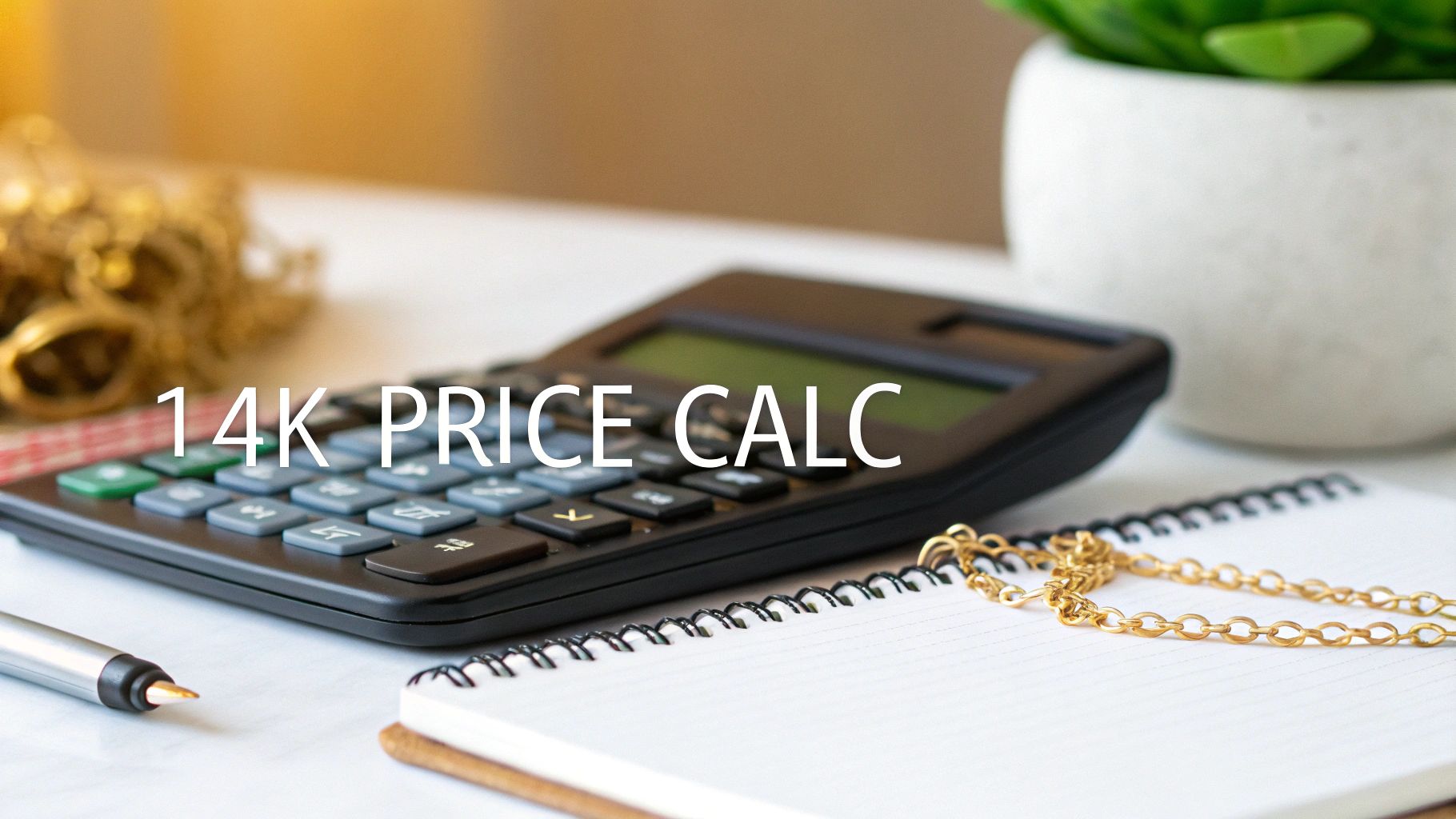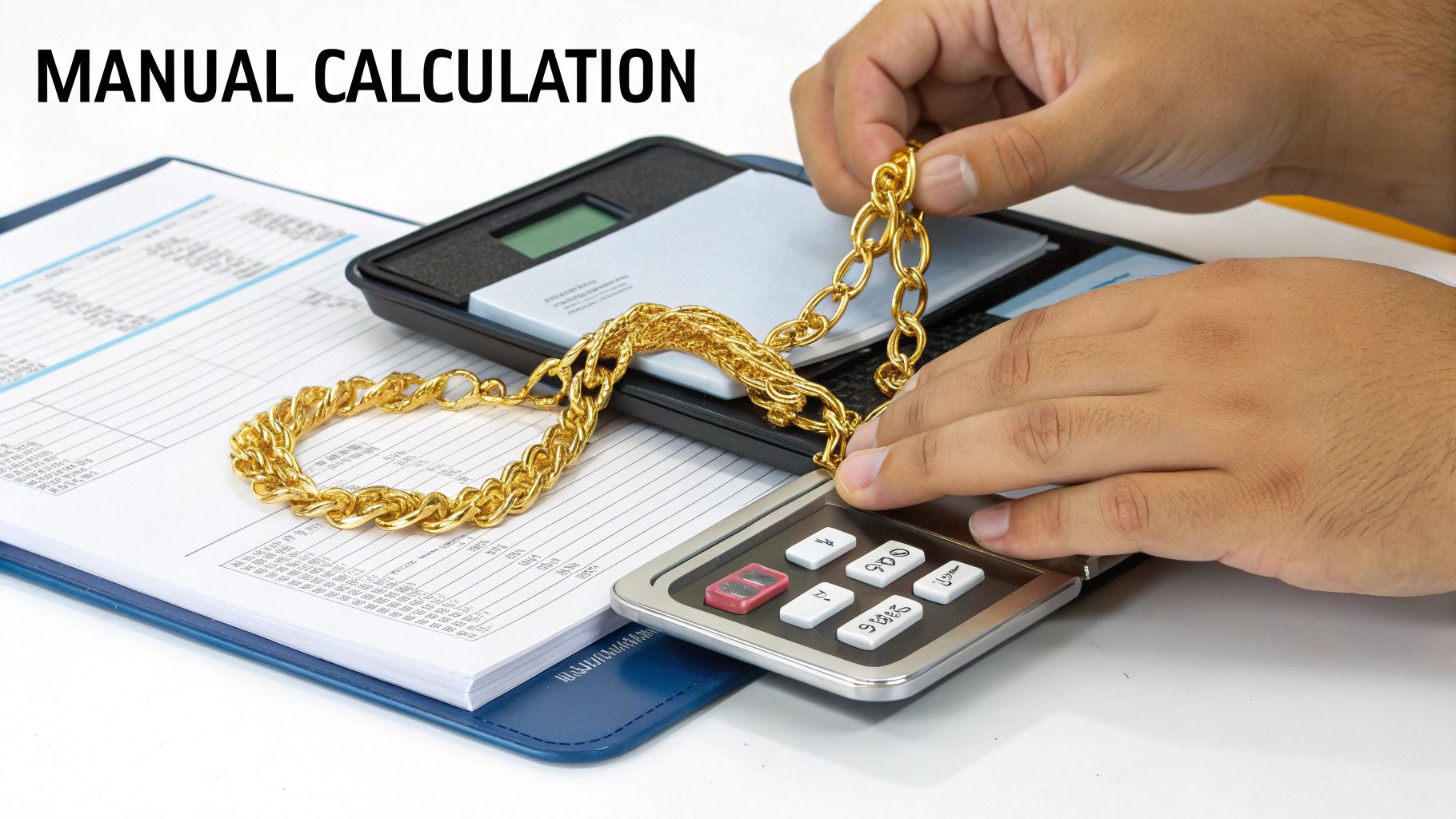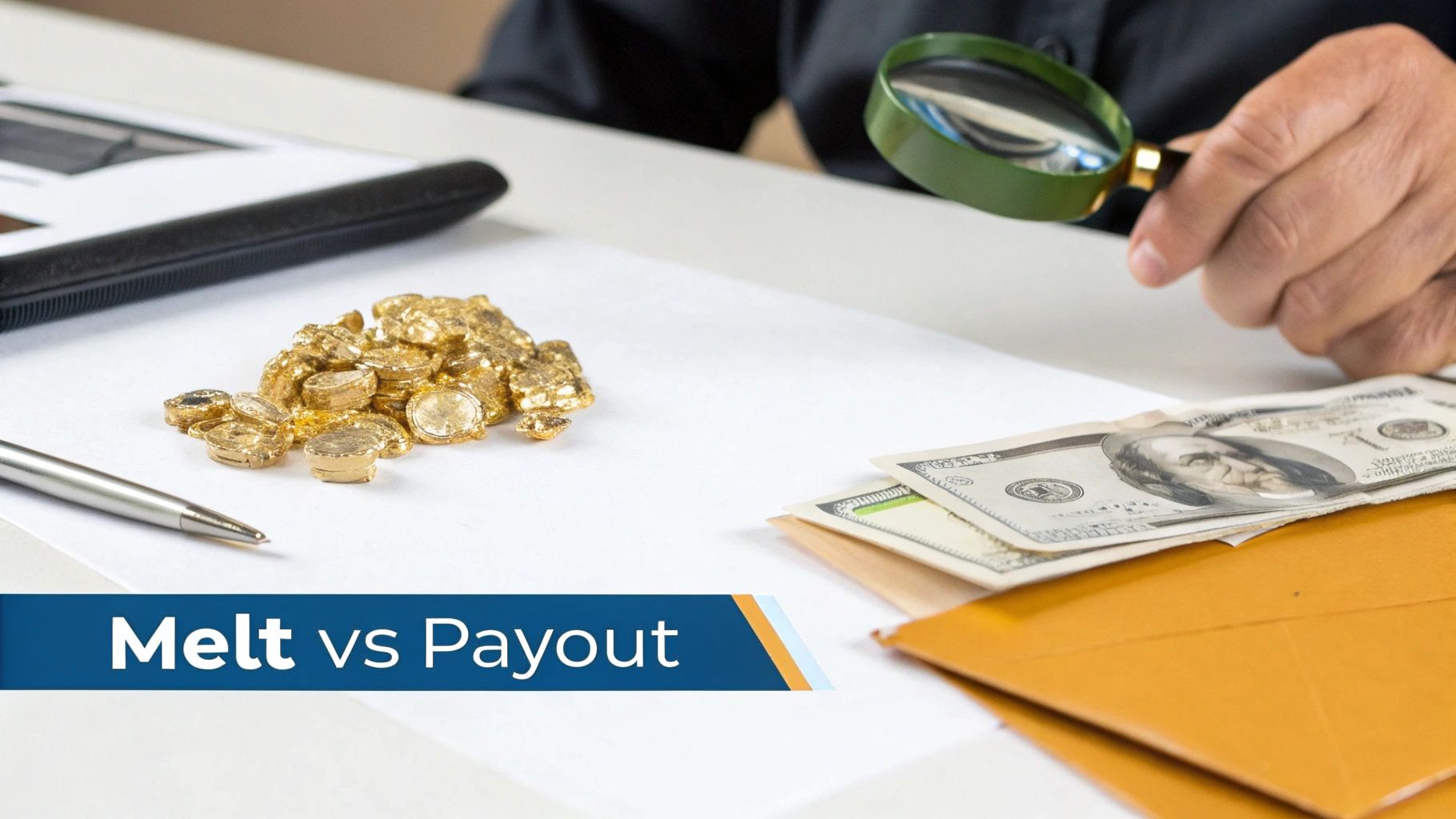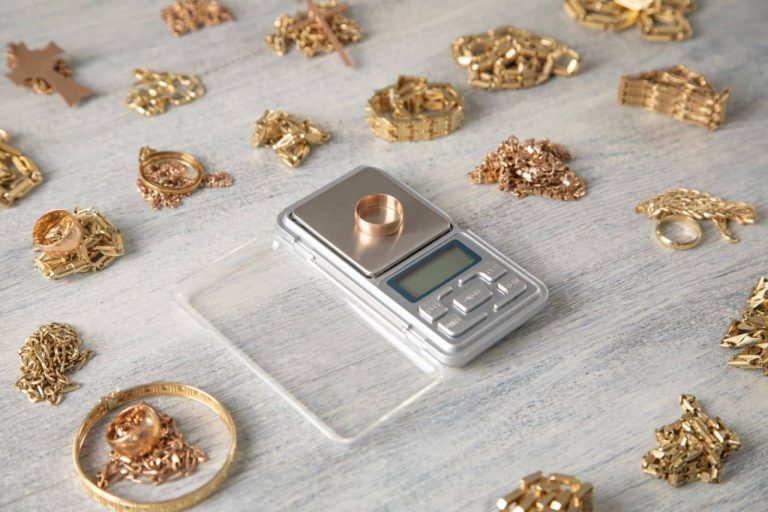14k Gold Price Per Gram Calculator Explained
Ever wonder what that old 14k gold jewelry stashed in your drawer is actually worth? The quickest way to get a solid estimate is with a 14k gold price per gram calculator, which works by multiplying the live price of pure gold by 0.583. This simple bit of math is the bridge connecting the global gold market directly to the value of the items you own.
Understanding the Value of Your 14k Gold

It is a common question I hear all the time: “What’s my gold necklace really worth?” People often feel like the answer is some big industry secret, but it is more straightforward than you might think. The key is understanding what that “14k” stamp truly means. It is not just a mark; it is a precise recipe for your gold’s purity.
The Math Behind the Melt Value
The term “karat” tells you exactly how much pure gold is in your item, measured out of 24 parts. Since pure, 24k gold is far too soft for everyday jewelry, it is mixed with stronger metals like copper, silver, or zinc to create a durable alloy. This is where 14k gold comes from.
A 14k gold price per gram calculator uses a simple, transparent formula: it takes the current market price (spot price) of pure 24k gold and multiplies it by 0.583. That number, 0.583, represents the 58.3% pure gold content in any 14k item.
For example, if the spot price of 24k gold is $75.00 per gram, the melt value of 14k gold would be calculated as $75.00 x 0.583 = $43.73 per gram. It is that simple. This is your baseline value.
Key Takeaway: The “melt value” you get from a calculator is the raw worth of the gold itself. Every gold buyer, from a local pawn shop to a large refiner, starts their pricing from this foundational number.
Purity Comparison at a Glance
Think of it like a recipe. Different karats just mean different ratios of gold to other metals. Getting a handle on this is the first step to accurately figuring out what your gold is worth. For a deeper look into the calculations, our guide on the gold calculation formula breaks it all down.
Here is a simple table showing the most common gold purities you will run into.
| Karat (K) | Gold Purity Percentage | Fineness (Parts per 1000) |
|---|---|---|
| 24K | 99.9% | 999 |
| 18K | 75.0% | 750 |
| 14K | 58.3% | 583 or 585 |
| 10K | 41.7% | 417 |
Knowing this empowers you. It lets you see exactly what a calculator is doing under the hood and why the price of 14k gold will always be a fixed percentage of the live 24k spot price. No mystery, just math.
Calculating Your Gold’s Value Without a Tool
While an online calculator is undeniably fast, knowing how to figure out your gold’s value by hand is a powerful skill. It pulls back the curtain on the whole process, giving you the confidence to check any offer you get and understand what your gold is truly worth at its core.
Let’s run through the numbers exactly like a professional would, using a real world scenario you can easily follow.
The first and most important piece of the puzzle is the spot price of gold. This is the live, up to the minute market price for one troy ounce of pure, 24k gold. You will find this price on any reputable financial news site or precious metals exchange, and it is constantly changing throughout the day.
Finding the Spot Price
First things first, you need a reliable source for the live gold price. Websites like GoldPrice.org, JM Bullion, or even major outlets like Bloomberg are the go to places. This price is the universal starting line for every gold transaction on the planet, from massive bank trades all the way down to a single gold chain.
Here is what a typical spot price chart looks like online.

This screenshot gives you the direct market data we need, showing the price in different weights and currencies.
Converting Ounces to Grams
Here is a step that trips a lot of people up. Spot prices are almost always quoted in troy ounces, but your jewelry is weighed in grams. The conversion is simple but absolutely critical.
Just remember this number: there are 31.1 grams in one troy ounce.
To get the price per gram, you just divide the spot price per ounce by 31.1.
Let’s say the spot price is $2,300 per troy ounce:
$2,300 / 31.1 grams = $73.95 per gram for pure 24k gold
That number, $73.95, is our baseline—the value of pure gold by the gram. Now we just have to adjust for the purity of your 14k item. For a deeper dive into these calculations, check out our full guide on how to calculate gold price.
Applying the 14k Purity Multiplier
As we know, 14k gold is not 100% pure. It is 58.3% gold, with other metals mixed in to make it strong enough for jewelry. To find the actual melt value of your 14k piece, you simply multiply the pure gold price per gram by that percentage.
Sticking with our example:
$73.95 (24k price per gram) x 0.583 (14k purity) = $43.11 per gram for 14k gold
This final figure, $43.11 per gram, is the raw melt value of your 14k gold. It is the real world value of the actual gold content in your item, based on today’s market.
A Practical Walkthrough
Let’s put it all together. Imagine you have a 14k gold chain that weighs 12 grams on a digital scale.
Here is the complete math from start to finish:
| Step | Action | Example Calculation | Result |
|---|---|---|---|
| 1. Find Spot Price | Get the live price of 24k gold. | $2,300 per troy ounce | $2,300 |
| 2. Convert to Grams | Divide the spot price by 31.1. | $2,300 / 31.1 | $73.95 / gram (24k) |
| 3. Adjust for Purity | Multiply by the 14k factor (0.583). | $73.95 x 0.583 | $43.11 / gram (14k) |
| 4. Calculate Total Value | Multiply by the item’s weight. | $43.11 x 12 grams | $517.32 |
So, the total melt value of that 12 gram 14k gold chain is $517.32. This is your benchmark number—the value before any buyer takes their cut for fees and profit. Knowing how to get this number yourself puts you in a much stronger position when it is time to sell.
What Really Drives the Price of Gold
When you plug numbers into a 14k gold price per gram calculator, you are seeing more than just a price. That number is a direct reflection of a massive, ongoing global conversation about money, stability, and power. The price of gold does not just appear out of thin air; it is constantly shifting based on a complex web of economic forces.
Getting a handle on these key drivers helps you see the bigger picture, moving beyond a simple calculation to understand why the price is what it is.
One of the biggest factors is inflation. When the purchasing power of currencies like the US dollar starts to get shaky, investors often flock to gold to protect their wealth. Think of gold as a physical store of value that cannot just be printed by a government, which makes it a very attractive safe harbor during times of economic uncertainty.
This is directly tied to another major influence: the strength of the US dollar. Gold is priced in US dollars on the global stage, creating an inverse relationship between the two. When the dollar is strong, it takes fewer dollars to buy an ounce of gold, so its price tends to dip. On the flip side, a weaker dollar often gives gold prices a nice boost.
Central Banks and Market Demand
It is not just individual investors moving the needle. Central banks around the world are some of the biggest players in the gold market, and their actions can have a huge impact.
When countries like China or India decide to make massive purchases to diversify their reserves away from the US dollar, this sudden spike in demand can send prices soaring. This is a classic case of supply and demand at work.
The demand for gold comes from a few key areas:
- Jewelry Production: This makes up a huge slice of annual gold demand, especially in rapidly growing economies where gold is culturally significant.
- Industrial Use: Gold is an incredible conductor and resists corrosion, making it essential in everything from electronics and dentistry to aerospace technology.
- Investment: This bucket includes everything from physical gold bars and coins to financial products like ETFs (Exchange Traded Funds).
The Big Picture: The price you get from a calculator is a single snapshot in time. It is influenced by everything from a Federal Reserve interest rate decision to the manufacturing demand for the next generation of smartphones.
Gold as a Safe Haven Asset
During times of global turmoil, gold truly earns its reputation as a “safe haven” asset.
When geopolitical tensions flare up, stock markets get choppy, or there is widespread instability, investors often run for cover and that cover is frequently gold. They see it as a secure place to park their money until the storm passes. This predictable flight to safety drives up demand and, you guessed it, the price.
This table breaks down the primary forces that can push gold prices one way or the other.
| Price Driver | Tends to Increase Gold Price | Tends to Decrease Gold Price |
|---|---|---|
| Inflation | High or rising inflation | Low and stable inflation |
| US Dollar | Weakening US dollar | Strengthening US dollar |
| Interest Rates | Low or falling rates | High or rising rates |
| Geopolitical Stability | High instability and conflict | Periods of peace and stability |
| Economic Outlook | Fear of recession or slowdown | Strong economic growth |
Over the last six months, the price of 14k gold per gram has shown some significant movement, reflecting these bigger trends. For example, in early November 2025, 14k gold was trading around $74.62 per gram.
This is a big jump from earlier in the year. The spot price for pure 24k gold climbed from roughly $87.95 per gram in May 2025 to a high of $112.57 per gram by early November—a 22.14% gain in just six months.
By keeping an eye on these global trends, you can start to make much smarter, more informed decisions about when might be the right time to sell your gold.
From Melt Value to Real-World Payouts

So you have used a 14k gold price per gram calculator and have a number in front of you. That figure is an absolutely crucial starting point, but it is important to know what it really represents: the raw, intrinsic value of the gold in your item. In the industry, we call this the “melt value.”
It is a common misconception to think this melt value is what a jeweler, pawn shop, or online buyer will hand you. It is not. Think of the melt value as the wholesale price of your gold. When you sell your pieces, you are selling a raw material that the buyer needs to test, process, and refine before they can turn a profit. And that process has costs.
Why Offers Are Always Lower Than Melt Value
A buyer’s offer is almost always presented as a percentage of the spot market value. This is not a shady practice; it is just the reality of the business. Buyers have to cover their operational costs—things like rent, insurance, and the specialized equipment needed to accurately test gold purity.
They also have to account for the labor involved in the transaction and the fees they pay to send the gold to a large scale refiner. Finally, they need a profit margin to stay in business. For all these reasons, you should expect offers to land somewhere in the 70% to 95% range of the calculated melt value. A reputable buyer will be upfront about this.
Realistic Expectations: Selling gold is not about getting 100% of the spot price—that is nearly impossible for a consumer. The real goal is to get the highest possible percentage from a trustworthy, transparent buyer.
Once you understand this gap between melt value and the final payout, you can negotiate from a much stronger position. You are no longer just focused on the number from the calculator but on the fairness of the percentage being offered.
Factors That Can Add Value Beyond the Melt
While most broken chains or simple gold bands are valued solely on their weight and purity, some items have a worth that goes far beyond their raw metal content. It is critical to identify these pieces before you start shopping them around for their scrap value.
Here are a few things that can significantly boost an item’s worth:
- Designer Brands: Jewelry from iconic houses like Cartier, Tiffany & Co., or Van Cleef & Arpels often carries a premium that has nothing to do with its gold content.
- Intricate Craftsmanship: A piece with exceptional handmade details, filigree, or a unique artistic design might be more valuable sold as a finished item rather than melted down.
- Antique or Historical Significance: Is it a Victorian locket or an Art Deco bracelet? Vintage and antique pieces often have collectible value completely separate from their weight in gold.
- Gemstones: Many scrap buyers only pay for the gold and will remove any stones. If your item has valuable gems like diamonds, sapphires, or emeralds, they need to be appraised on their own.
Knowing the purity of your gold is the foundation for any valuation. This table breaks down the most common karat levels you will encounter.
Gold Karat Purity and Content Comparison
| Karat (K) | Purity Percentage | Fineness (Parts per 1000) |
|---|---|---|
| 24K | 99.9% | 999 |
| 18K | 75.0% | 750 |
| 14K | 58.3% | 583 or 585 |
| 10K | 41.7% | 417 |
Recognizing these purity levels helps you calculate the base melt value accurately.
Ultimately, distinguishing between “scrap” and “resellable jewelry” is key. For a simple, broken gold chain, the melt value is your best guide. But for a signed antique bracelet with gemstones, you should seek an appraisal from a specialist jeweler, not just a scrap gold buyer. Making that distinction is how you ensure you do not accidentally sell a valuable heirloom for a fraction of its true worth.
Actionable Tips for Selling Your 14k Gold

Knowing your gold’s real value is your biggest advantage when it is time to sell. When you walk into a negotiation armed with an accurate melt value from a 14k gold price per gram calculator, you are in the driver’s seat. These practical tips will help you turn that knowledge into the best possible price for your items.
One of the most powerful things you can do is get quotes from several reputable buyers. Do not ever settle for the first offer. Payout percentages can vary wildly from one dealer to the next, and shopping around is the only way to find out who is offering a fair rate. Try to visit at least three different places—a local jeweler, a coin shop, and a dedicated precious metals dealer—to get a solid feel for the market.
It is also non negotiable to know your item’s weight before you go anywhere. Weighing your jewelry at home on a calibrated digital scale is your best defense against being shortchanged. It lets you confirm the buyer’s measurements right there on the spot, keeping the whole transaction transparent.
Prepare Your Items for the Best Offer
Here is a simple pro tip: separate your jewelry by karat before you even leave the house. Put your 10k, 14k, and 18k pieces into different bags. This small step signals to the buyer that you are organized and have done your homework, which often leads to a smoother, more favorable deal.
Expert Advice: Whatever you do, do not clean your gold before selling it, especially if the piece is an antique. Aggressive polishing can strip away the natural patina that gives a vintage piece its character and value, potentially lowering its worth.
A big part of navigating the selling process is knowing what to avoid. Be wary of any buyer who uses high pressure tactics or tries to rush you into a decision. A trustworthy dealer will always give you time to consider their offer without making you feel cornered. Our comprehensive guide offers more insights on where to sell gold for the highest price.
Spotting Red Flags
Be extra cautious with mail in services, particularly those with a history of bad reviews or unclear payout structures. Taking a few minutes to research a company’s online reputation is a crucial step before you trust them with your valuables.
| Common Red Flag | Why It Is a Concern |
|---|---|
| No Physical Address | Legitimate businesses are transparent about their location. |
| High Pressure Sales | A fair offer does not require aggressive tactics to be accepted. |
| Vague Payout Terms | You should know exactly what percentage of the spot price you will receive. |
| No Scales Visible | The weighing process should be done in front of you on a certified scale. |
Understanding gold’s historical performance also provides valuable context. Over the last 40 years, the price of 24k gold has climbed from just $8.13 per gram to a high of $139.48 per gram—a massive 1,715% increase. While the price of 14k gold is naturally lower due to its purity, its percentage gains have consistently mirrored those of pure gold, proving its incredible long term value.
Got Questions About Valuing 14k Gold? We’ve Got Answers.
Let’s tackle some of the most common questions that pop up when you are trying to figure out your gold’s value. Getting these details straight from the start will give you the confidence you need to get a fair price.
One of the first things people notice is the gap between the price on a 14k gold price per gram calculator and the offer they get from a buyer. It is a totally normal question. The calculator gives you the “melt value”—the raw worth of the gold based on live market prices. A buyer, however, has to account for their own business costs. This includes testing, the complex process of refining, and of course, their own profit margin. That is why their offer will be a percentage of the melt value, usually somewhere between 70% and 95%.
How Can I Tell Different Gold Karats Apart?
Another frequent question is about identifying karats just by looking. While a professional acid test is the only way to be 100% sure, most jewelry gives you a big clue with a tiny stamp called a hallmark.
These little markings tell you the purity of the piece. Knowing what to look for makes it much easier to sort your items before you even think about getting a quote.
A Quick Tip: Hallmarks are usually hidden in discreet spots, like the inside of a ring’s band or on the clasp of a necklace. They can be incredibly small, so you might need a magnifying glass to read them clearly.
Spotting these stamps helps you organize your jewelry and understand what you are working with.
Does Gold Color Change Its Melt Value?
This one causes a lot of confusion. Is a 14k rose gold ring worth something different than a 14k yellow gold one?
The short answer is no. The value comes from the pure gold content, not the color.
The color you see is determined by the other metals (alloys) mixed in with the gold.
- Yellow Gold: This is the classic look, typically made by mixing pure gold with silver and copper.
- White Gold: To get that silvery finish, gold is alloyed with white metals like palladium or nickel. It is often plated with rhodium to make it even brighter.
- Rose Gold: That warm, pinkish color comes from adding a higher amount of copper to the mix.
No matter the color, if an item is stamped “14k,” it means it contains 58.3% pure gold. The other 41.7% is made up of those alloy metals that create the color, and they do not factor into the gold’s melt value. So, a 10 gram 14k white gold chain has the exact same amount of pure gold—and the same melt value—as a 10 gram 14k yellow gold chain.
Here is a simple breakdown of what goes into each color.
| Gold Color | Primary Alloying Metals | Impact on Melt Value |
|---|---|---|
| Yellow Gold | Silver, Copper, Zinc | None |
| White Gold | Palladium, Nickel, Silver | None |
| Rose Gold | Copper | None |
With these common questions cleared up, you are in a much better position to use a calculator, understand the offers you get, and sell your gold like a pro.
Ready to discover the true value of your gold with precision and ease? Use our free, real time live gold price calculator to get an instant, transparent estimate based on live market prices.








